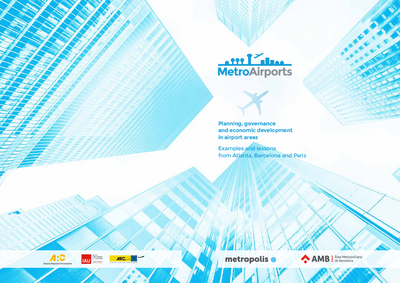MetroAirports
Planning, governance and economic development in airport areas is the final report of the project "METROAirports; Socioeconomic impact and uses of new-generation airports", led by the Barcelona Metropolitan Area, with the Atlanta Regional Commission and L'Institut Paris Region as partners, and the Airport Regions Conference as an associated partner.
METROAirports is the continuation of the“Sustainable Airport Areas” project, which was carried out from 2015 to 2017 under the leadership of L'Institut Paris Region. This initiative resulted in the publication of the document Sustainable Airport Areas. Guidelines for Decision Makers.
The aim of METROAirports was to build on prior experience and further elaborate on four main topics:
- Conceptualisation of airport areas. The previous project provides various definitions of “airport areas”, although the definitions acknowledge that perimeters vary according to the approach. Additionally, other concepts such as airport city, airport corridor and airport area are sketched, although their contours are often blurred. This project aims to provide further clarity on these concepts, as the question “What is an airport area?” has implications for the planning, governance and economic policy fields.
- Airport area planning. Planning airport areas is typically a challenge for land planning authorities, since a substantial portion of the land is controlled by an airport company that acts as an “extraterritorial” entity. Planning authorities need to strike a balance in airport areas between development on the one hand and the protection of the environment and local communities on the other. This is especially the case now as these zones are becoming hot spots for urban development, while local communities often see the airport as a nuisance more than as an opportunity.
- Governance of airport areas. The previous project pointed to several examples of good practices involving various stakeholders in airport areas, with a range of partners collaborating in the fields of raising awareness, economic development, international promotion, employment and environmental protection. However, in this report we intend to go further and develop a map of the stakeholders typically present in airport areas and identify their interests, priorities and the ability/power of each to influence public decisions.
- Fostering economic development and jobs. Quite often, airports are surrounded by economically depressed areas and hence authorities are keen to implement schemes to bring airport-related employment opportunities closer to local communities. One obstacle to this goal is that while airports tend to have good transport links to central cities, this is less true of neighbouring towns, a reality that hinders the access of local communities to airport-related jobs.
This report is to be considered an initial step in the exploration of these lesser explored territories. Experiences and inputs from Atlanta, Barcelona and Paris have provided a lot of interesting information from airports of different scales located in different geographic, historic, political and social environments. However, having studied the areas surrounding only four airports (ATL, CDG, ORY and BCN), this report is limited by definition, and it would be wise to seek confirmation for the conclusions stemming from this research by examining experiences elsewhere. To this end, the dissemination and networking capacities of Metropolis and the Airport Regions Conference may prove useful in promoting exchanges and discussions with other airport areas.
This study is linked to the following themes :
International |
Economy |
Governance |
Mobility |
Urban planning
